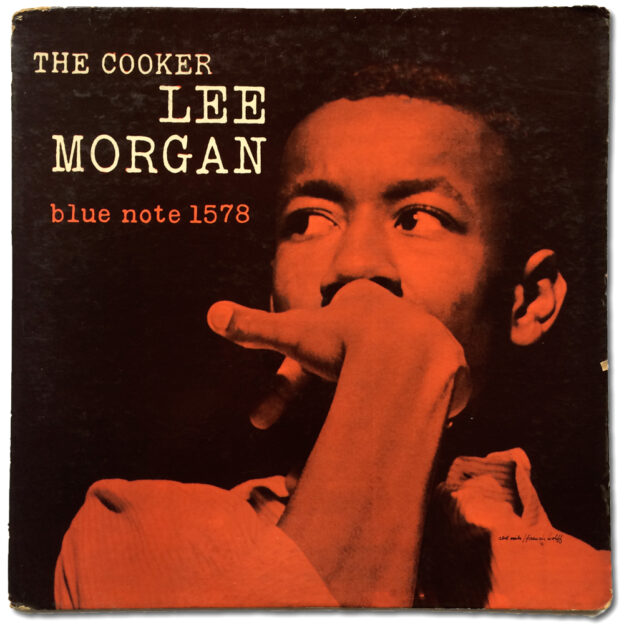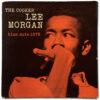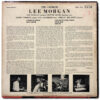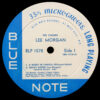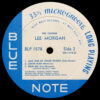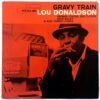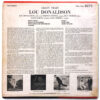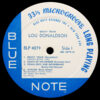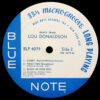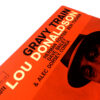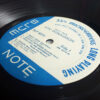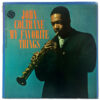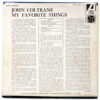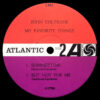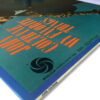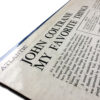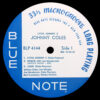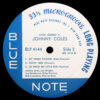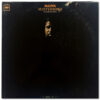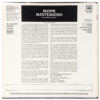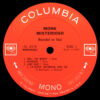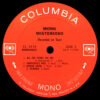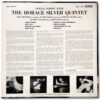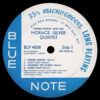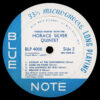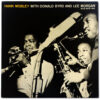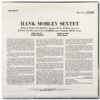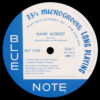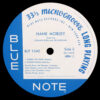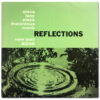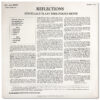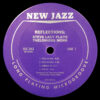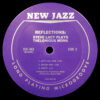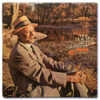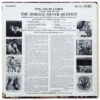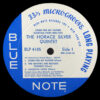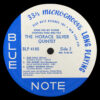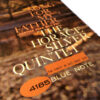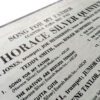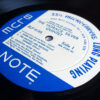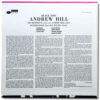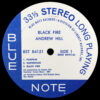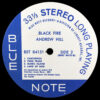- Original 1957 mono pressing
- West 63rd address on both labels without registered trademark “R”
- Deep groove on both sides
- Plastylite “P” etched and “RVG” stamped in dead wax
Personnel:
- Lee Morgan, trumpet
- Pepper Adams, baritone saxophone
- Bobby Timmons, piano
- Paul Chambers, bass
- “Philly” Joe Jones, drums
Recorded September 29, 1957 at Van Gelder Studio, Hackensack, New Jersey
Originally released in November 1957
Selection: “Heavy Dipper” (Morgan)
A while ago I happened upon the YouTube channel of “KoolKatJazz”, a collector who takes pride in finding cheap original pressings of vintage jazz records that, while perhaps grade VG or lower, sound great at times nonetheless. Being a collector on a pretty strict budget made me think that this might be a collecting strategy I could benefit from.
Then I came across this copy of The Cooker. It looked VG at best, and while I would normally pass on a record like this due to a personal intolerance of audible wear and loud pops and ticks, this time I had the opportunity to preview the playback before buying. Indeed, the record had its share of loud ticks and even a skip at one point, but no distortion, and at times the thing sounded undeniably brilliant. The price was more than fair so I decided to go for it.
Though I was originally under the impression that mono issues of this album are quite rare, collecting buddy Clifford Allen informed me that in addition to a West 63rd “R” repressing, mono pressings with New York USA and even United Artists “classic” labels exist. Shout out to Clifford for helping make this article more accurate!
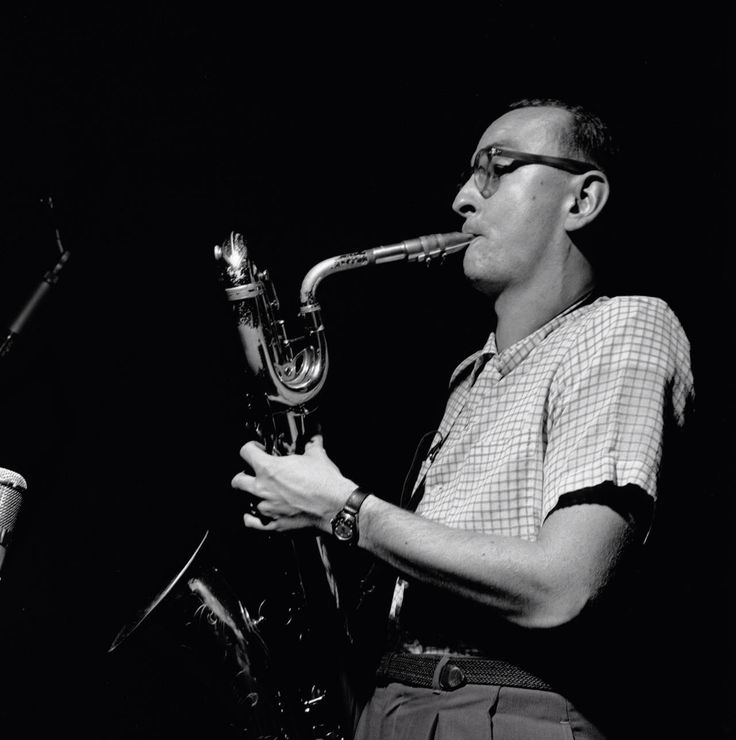 |
| Pepper Adams during the recording of The Cooker in 1957 |
I had never heard these sides before I found this copy. I’m not the biggest fan of the mega-standard “A Night in Tunisia” and accordingly was a little underwhelmed by this epic reading. But just as I began to fear that the date would ultimately amount to no more than “another bop blowing session”, Pepper Adams’ quirky presence grew on me, and I soon came to appreciate this pleasantly odd frontline pairing of trumpet and baritone sax. Prior to the release of The Cooker, Morgan had never laid to tape any of his own compositions, and thus with “Heavy Dipper” and “New Ma”, the world got its first glimpse of the leader’s talents as a songwriter. And most collectors will be able to appreciate the magic contained in these fresh 1957 mono Plastylite grooves.
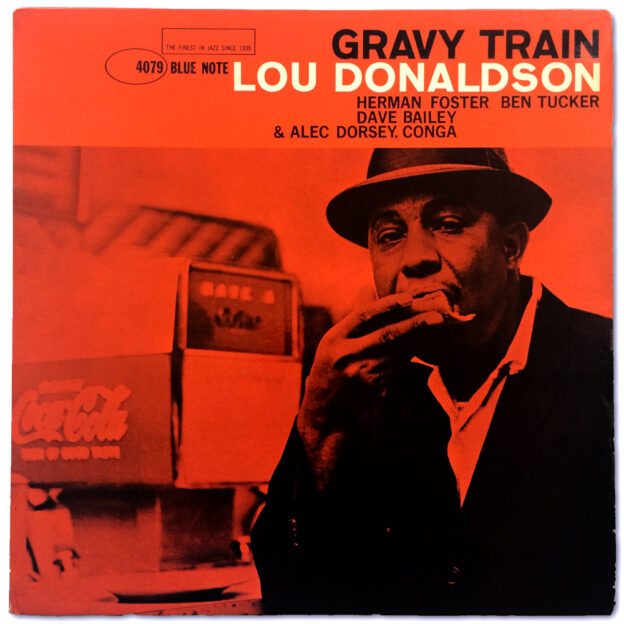
Vinyl Spotlight: Lou Donaldson, Gravy Train (Blue Note 4079) Original Mono Pressing
- Original 1962 mono pressing
- “NEW YORK USA” on both labels
- Plastylite “P” etched and “RVG” stamped in dead wax
- “43 West 61st St., New York 23” address on jacket
Personnel:
- Lou Donaldson, alto saxophone
- Herman Foster, piano
- Ben Tucker, bass
- Dave Bailey, drums
- Alec Dorsey, conga
Recorded April 27, 1961 at Van Gelder Studio, Englewood Cliffs, New Jersey
Originally released June 1962
| 1 | Gravy Train | |
| 2 | South of the Border | |
| 3 | Polka Dots and Moonbeams | |
| 4 | Avalon | |
| 5 | Candy | |
| 6 | Twist Time | |
| 7 | Glory of Love |
Selection: “Gravy Train” (Donaldson)
The first copy I owned was a VG copy I won on eBay in the dawn of my vintage jazz record collecting experience. I quickly replaced that worn copy with a wear-free but crackly copy. A couple years later I found a copy on eBay whose record was touted as VG+ but the jacket was exceptional (sometimes if a jacket is graded conservatively I’ll take a chance on a VG+ record).
That third copy ended up being fairly graded VG+. It looked EX but suffered from a mild case of…dun dun duuun: groove wear. I ultimately gave it up, not feeling it was worth what I paid. Then last year I found this copy at a local record shop for a much more reasonable price. It suffers from groove wear in much the same way as the last copy (the wear being less audible on the outermost tracks like my favorite, “Gravy Train”, as a result of inner groove distortion), and the jacket isn’t as clean as the last either, but I feel that its price more accurately represented its condition than the previous copy I owned. Generally speaking, the records that end up staying im my collection aren’t always the nicest but they always were purchased for a fair price.
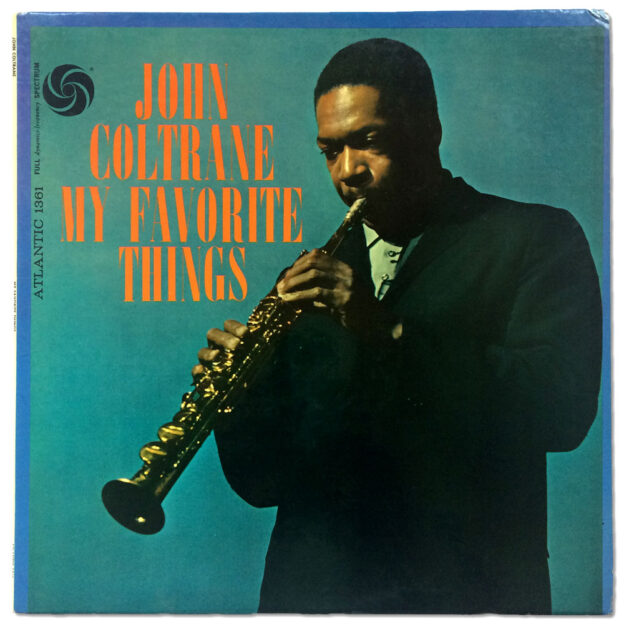
Vinyl Spotlight: John Coltrane, My Favorite Things (Atlantic 1361) Second “Black Fan” Mono Pressing
- Second mono pressing circa 1962-1966
- Orange & purple label
- Black fan logo on both sides
- Side 1/2 matrix: 11755-A “AT” / 11756-B “AT”
Personnel:
- John Coltrane, soprano & tenor saxophones
- McCoy Tyner, piano
- Steve Davis, bass
- Elvin Jones, drums
“My Favorite Things” recorded October 21, 1960
“Summertime” recorded October 24, 1960
“Everytime We Say Goodbye” and “But Not for Me” recorded October 26, 1960
All selections recorded at Atlantic Records’ 56th Street studio, NYC
Originally released March 1961
| 1 | My Favorite Things | |
| 2 | Everytime We Say Goodbye | |
| 3 | Summertime | |
| 4 | But Not For Me |
Selection: “My Favorite Things” (Rodgers-Hammerstein)
My Favorite Things is a magical album that is up at the top of my favorite Coltrane records. Those of you who read along here on a regular basis have probably picked up on the fact that I often favor “quieter” sounding jazz. My Favorite Things is no exception. Coltrane plays the soprano saxophone with great passion but it’s never overbearing. I also appreciate the accompaniment of Elvin Jones and McCoy Tyner, a brave young combo playing with less abandon on the eve of their leader’s ascent into the heavens of the avant-garde.
This record has a really unique, sweet sound. Engineer Tom Dowd had a way of making pianos sound soft and even ghostly with just a touch of tube amplifier overdrive. We heard that sound on Giant Steps for Tommy Flanagan and we hear it again here with Tyner, a most welcome coloring of the piano’s sonic palette.
Before I stole this original mono pressing on eBay in a weeknight-ending auction, I had heard this album in stereo my entire life. I’m not one to overhype differences in various versions of an album usually but hearing the original mono pressing of this album for the first time was profound. None of these four brilliant musicians are competing to be heard here, and the mono presentation succeeds at unifying the music without sacrificing each player’s individuality. As warm as this recording sounds even in its digital stereo incarnation, this pressing accentuates that. It’s one of the most dramatically different listening experiences I’ve had comparing a record to its digital counterpart, sonically making this one of my favorite LPs to listen to.

Vinyl Spotlight: Johnny Coles, Little Johnny C (Blue Note 4144) Original Mono Pressing
- “Earless NY” mono pressing ca. 1966
- “NEW YORK USA” on both labels
- “VAN GELDER” stamped in dead wax
- “43 West 61st St., New York 23” address on jacket with “Printed in U.S.A.”
Personnel:
- Johnny Coles, trumpet
- Leo Wright, alto saxophone & flute
- Joe Henderson, tenor saxophone
- Duke Pearson, piano
- Bob Cranshaw, bass
- Walter Perkins (Side 1) and Pete La Roca (Side 2), drums
Side 1 recorded July 18, 1963
Side 2 recorded August 9, 1963
All selections recorded at Van Gelder Studio, Englewood Cliffs, New Jersey
Originally released February 1964
| 1 | Little Johnny C | |
| 2 | Hobo Joe | |
| 3 | Jano | |
| 4 | My Secret Passion | |
| 5 | Heavy Legs | |
| 6 | So Sweet My Little Girl |
Selections:
“Little Johnny C” (Pearson)
“Jano” (Pearson)
“So Sweet My Little Girl” (Pearson)
Song for song, start to finish, this is a brilliantly executed body of work, and session pianist Duke Pearson deserves the lion’s share of the credit. As composer of five of the album’s six tracks, Little Johnny C demonstrates Pearson’s talents in a leadership role and points to his timely inclusion in the Blue Note family as an A&R man and producer.
Recorded on two separate dates, the program undergoes a drummer change between sides 1 and 2 while the frontline is maintained. Walter Perkins sits at the throne for the album’s most fast-paced tracks (“Little Johnny C” and “Jano”), his playing unique and imaginative on both takes. Coles seems to follow Miles in his “less is more” approach to solos, and Leo Wright’s work on alto sax is perhaps the finest of all the album’s soloists, arguably topping even tenor heavyweight Joe Henderson.
Engineer Rudy Van Gelder’s Englewood Cliffs recording studio typically exerts a roomy, larger-than-life sound on recordings. But in a rare break from routine, producer Alfred Lion has opted for a tighter, more up-close-and-personal sound here reminiscent of the days in Hackensack. The result is a unique take on the Blue Note sound that has the immediacy of a Hackensack record but also the clarity and definition of Englewood Cliffs.
Little Johnny C is a delightful roller coaster ride that ends with a slow and gentle stop. Rising and dipping between up-tempo and mid-tempo readings, the listener finally arrives at “So Sweet My Little Girl”, a heartfelt ballad unmatched in its syrupy pace. Pearson rightfully concludes the album with a string of breathtaking notes that comprise one of the most perfect endings to a song I have ever heard.

Vinyl Spotlight: Thelonious Monk, Misterioso (Columbia 2416) Original Mono Pressing
- Original 1966 mono pressing
- “2-eye” labels
Personnel:
All but “Misterioso”, “Light Blue”, and “Evidence”:
- Charlie Rouse, tenor saxophone
- Thelonious Monk, piano
- Larry Gales, bass
- Ben Riley, drums
“Misterioso”, “Light Blue”, and “Evidence” only:
- Charlie Rouse, tenor saxophone
- Thelonious Monk, piano
- Butch Warren, bass
- Frankie Dunlop, drums
“Evidence” recorded May 21, 1963 at Sankei Hall, Tokyo
“Light Blue” recorded July 4, 1963 at Newport Jazz Festival, Newport, RI
“Misterioso” recorded December 30, 1963 at Lincoln Center, New York, NY
“I’m Getting Sentimental Over You” and “All the Things You Are” recorded November 1, 1964 at The It Club, Los Angeles, CA
“Bemsha Swing” recorded November 4, 1964 at The Jazz Workshop, San Francisco, CA
“Well, You Needn’t” recorded February 27, 1965 at Brandeis University, Waltham, MA
“Honeysuckle Rose” recorded March 2, 1965 in New York, NY
Originally released in 1966
Selection: “Light Blue” (Monk)
1. Some of Monk’s most inspired recordings were for Blue Note in the late ’40s and early ’50s. As a result, they are not high-fidelity and I don’t find myself seeking out older recordings like this on vinyl.
2. Though Monk’s recordings for Prestige are generally of outstanding quality in terms of both fidelity and performance, the sequencing of these recordings for Monk’s Prestige LPs is scattered in comparison to the original 10″ LP sequences, which make more sense to me.
3. I enjoy many of Monk’s Riverside releases but I’ve never found vintage Riverside pressings to be of a very high quality. I’ve owned a few but resold them shortly after acquiring them.
4. Much of Monk’s output for Columbia included songs he had already recorded for other labels in the past, and in most cases I prefer the older recording. No doubt, Monk’s Columbia recordings are of exceptionally high fidelity, but I do find that his playing on older albums sounds a little more inspired. I also don’t feel that the pinpoint accuracy of the Columbia recordings suits Monk’s music as well as the sonic signature of studios like Hackensack (Prestige and some Riverside) and Reeves (Riverside).
One of the exceptions to 4. above is this compilation of previously unreleased live material. Knowing that Monk felt his studio albums primarily served as advertisements for his live performances, I’ve taken a stronger interest in the pianist’s live albums. Although this album was released relatively close to the death knell of mono in 1964, and despite the fact that Columbia had been releasing brilliant-sounding stereo LPs for several years by that time, I still cherish the mono version of this album because the stereo mixes of Monk on Columbia fail to position the leader in the center of the stereo field.
This album has sentimental value to me because it served as my introduction to Monk when I borrowed my friend’s copy many years ago and this is the second original mono copy I’ve owned. The first was in pretty good shape but last year at the WFMU Record Fair I stumbled upon this copy in near-new condition, and for the asking price I couldn’t pass it up.
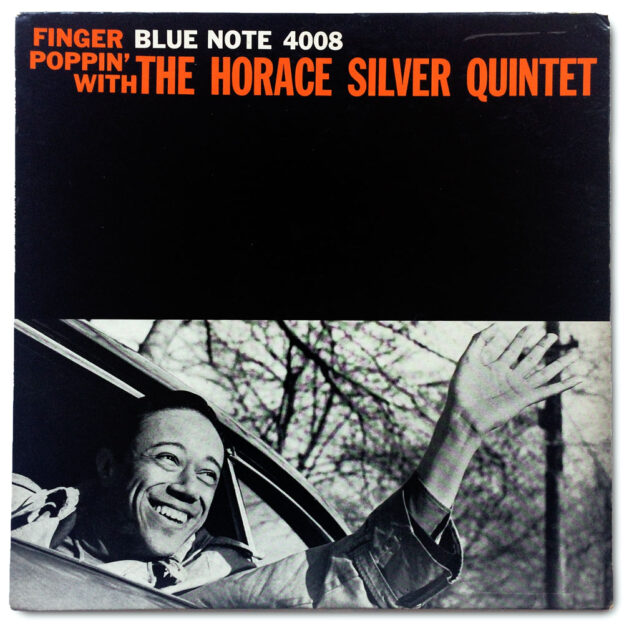
Vinyl Spotlight: Finger Poppin’ with the Horace Silver Quintet (Blue Note 4008) Original Mono Pressing
- Original 1959 mono pressing
- West 63rd address on both labels without registered trademark “R”
- Deep groove on both sides
- Plastylite “P” etched and “RVG” stamped in dead wax
- “47 West 63st St., New York 23” address on jacket
Personnel:
- Blue Mitchell, trumpet
- Junior Cook, tenor saxophone
- Horace Silver, piano
- Eugene Taylor, bass
- Louis Hayes, drums
Recorded January 31, 1959 at Van Gelder Studio, Hackensack, New Jersey
Originally released February 1959
| 1 | Finger Poppin’ | |
| 2 | Juicy Lucy | |
| 3 | Swingin’ The Samba | |
| 4 | Sweet Stuff | |
| 5 | Cookin’ at the Continental | |
| 6 | Come on Home | |
| 7 | You Happened My Way | |
| 8 | Mellow D |
Selection: “You Happened My Way” (Silver)
After doing a little research, a controversial Music Matters online article led me to the incorrect conclusion that Blue Note albums recorded after Halloween 1958 were intended for stereo release despite their mono counterparts being more valuable. So I found an original stereo copy via eBay Buy It Now (this was one of the earliest Blue Note stereo albums with the rectangular gold “STEREO” sticker). This copy was overpriced, over-graded, and didn’t sound much better than my mono copy.
A couple years went by without my giving much thought to vintage jazz records when I decided to give the hobby another go. Around this time I got lucky winning an auction that ended on a weekday morning for a very fair price, and that record is being presented here. It has its fair share of pops and ticks but it’s managed to remain in my collection because it’s wear-free, it’s a first pressing, and the cover and labels are both in great shape.
Shortly after acquiring this copy through the mail, I debated on whether I preferred the stereo or mono version of this album. I remember liking how I could hear all of the nuances of Louis Hayes’ drum kit on the stereo copy, but I also didn’t like the way Horace Silver was crammed in the left-hand corner of the mix along with the trumpet. Both mixes had their pluses and minuses, but after doing a lot of research I came to the conclusion that this album was meant to be heard in mono so I sold my stereo copy largely on principle. (Someday I might buy another original stereo copy, though. The spread was super-wide and it was a real treat to hear Louis Hayes’ drumming in such isolation.)
It’s fun to reminisce about the early days of my collecting, back when it was all so new and fresh to me, back when I had as much first-hand experience with mono Blue Note originals as I had with unicorns, back when I would marvel at the value of mono Blue Note originals in the Goldmine price guide. It’s crazy to think about how far removed I am from that place today both in terms of knowledge and experience. I’m a wiser collector with the collection to prove it but I do miss that sense of wonder.
This isn’t one of my favorite Horace Silver albums but it does include some of my favorite songs. I played the title track over and over again when I was auditioning my various copies of this album and it stuck with me. To this day, the opener’s frantic bebop is an exhilarating listen and has ultimately served as my introduction to the legendary, bold mono sound of original Blue Note pressings. “Sweet Stuff” is in the Silver tradition of syrupy ballads like “Shirl” and “Lonely Woman”, though that doesn’t make it any less enjoyable of a listen. And despite it not standing out initially, “You Happened My Way” is a beautiful melancholy number that has since become a favorite Silver composition.
Someday I’d love to own a clean first pressing of this album, which in all likelihood wouldn’t cost me an arm and a leg. Luckily, Silver was a very popular artist in his day so I reckon that the chances of this happening are pretty good.
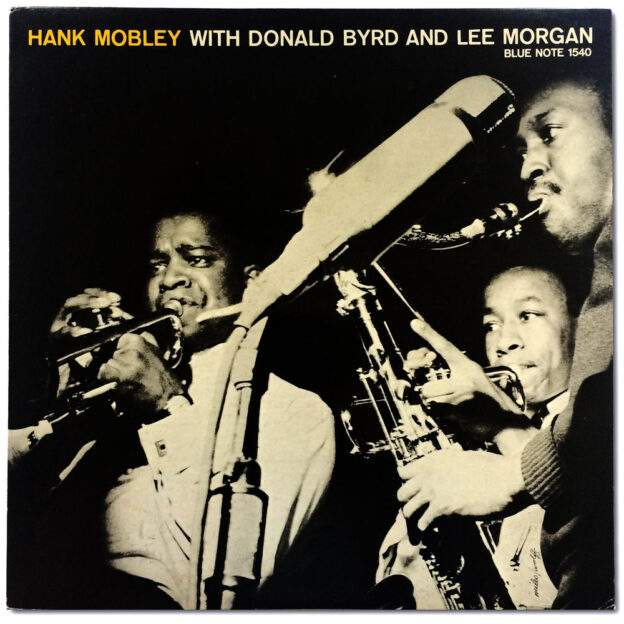
Vinyl Spotlight: Hank Mobley with Donald Byrd and Lee Morgan (Blue Note 1540) Toshiba Reissue
- Japanese Toshiba reissue circa 1983 (BN 1540)
Personnel:
- Donald Byrd, trumpet
- Lee Morgan, trumpet
- Hank Mobley, tenor saxophone
- Horace Silver, piano
- Paul Chambers, bass
- Charlie Persip, drums
Recorded November 25, 1956 at Van Gelder Studio, Hackensack, New Jersey
Originally released January 1957
Selection: “Touch and Go” (Mobley)
Selection: “Double Whammy” (Mobley)
There was something different about this sound, though. The horns had a tremendous sonic impact. The unique arrangement of two trumpets and one tenor saxophone was certainly playing a role, but recording engineer Rudy Van Gelder had clearly found a rare synergy with his equipment that day and I have yet to hear this horn sound topped by any other jazz recording. It is intense, smooth, and cohesive all at once. Van Gelder was getting a similar sound on other albums in late 1956 but perhaps the particular combination of Mobley, Byrd, and Morgan sets this album apart. The engineer’s choices regarding microphone positioning, preamplifier gain, compression, and instrument balance certainly played a role in the creation of this monumental sound as well.
The album’s compositions, all written by leader Hank Mobley, are consistently menacing. The haunting harmonies of “Touch and Go” and “Double Whammy” carry a sense of foreboding, and while “Barrel of Funk” has a rather upbeat “A” section, the tune ultimately transforms into an intriguing progression of minor-key origins at its bridge. Even the album’s most upbeat tune, “Mobleymania”, manages to keep listeners on the edge of their seats with harmonic tension.
Blue Note catalog number 1540 features Mobley’s characteristic sweet, smooth tone throughout. As a youthful pair of trumpeters, Donald Byrd and Lee Morgan are difficult to tell apart. Horace Silver does little to detract from this star-studded frontline, and the forefather of bop humbly yet tastefully blends into the background for much of the program. Silver’s comping is never boastful here, but at the same time it falls short of embodying the pianist’s big musical personality and signature funk (it wouldn’t be long before Silver would ditch sideman work for good and become the leader of his own legendary quintet). To round things out, drummer Charlie Persip sits at the throne behind his drum kit in the far corner of Rudy Van Gelder’s living room studio. I cannot get enough of the beautiful simplicity of Van Gelder’s mono drum sound at Hackensack in the late ’50s. Persip sounds just as good as anyone in that room and his straight-ahead timekeeping compliments Van Gelder’s technique exceedingly well.
Beyond a repress in the late ’60s after Blue Note had been sold to Liberty Records (the proof of which lies in the existence of copies with “RVG” etchings but no “ear”), this album has never been reissued in the United States, not even on compact disc (it has, however, appeared on numerous compilations including Mosaic’s box set of Mobley’s ’50s Blue Note recordings). The Japanese almost never left a Blue Note stone unturned though and this album is no exception, having been reissued by Toshiba-EMI five times in various formats. I was also considering the King reissue from the same year when I bought this 1983 Toshiba copy on eBay from a Japanese seller but ultimately chose the Toshiba not only because it was cheaper but I also noticed that the fonts used on the Toshiba cover more accurately portrayed those of the original artwork (King album covers also often admit an unnaturally high level of contrast). This was my first Japanese Blue Note vinyl reissue venture and I remember being stunned by how dead-quiet this pressing was.
My dream is to someday own a vintage copy of this album with RVG etchings. Until then, this Toshiba reissue is sure to get lots of turntable time in my house.
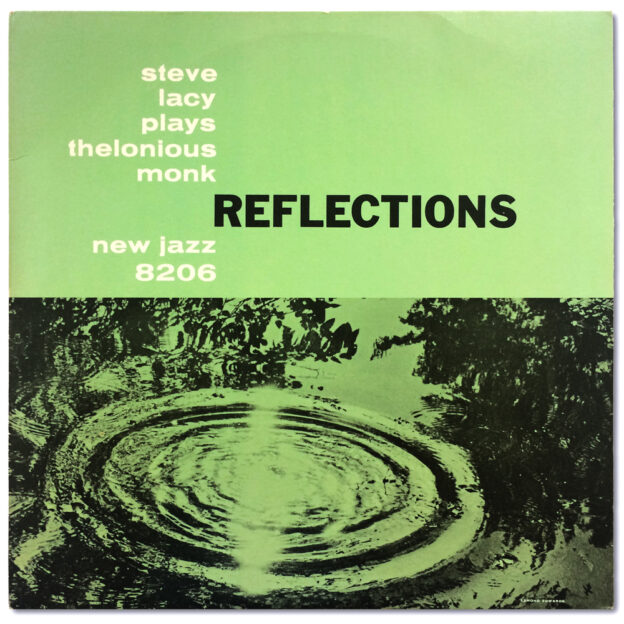
Vinyl Spotlight: Reflections: Steve Lacy Plays Thelonious Monk (New Jazz 8206) OJC Reissue
- Original Jazz Classics reissue circa 1983 (OJC-063)
- “GH” etched in dead wax (side 2 only)
Personnel:
- Steve Lacy, soprano saxophone
- Mal Waldron, piano
- Buell Neidlinger, bass
- Elvin Jones, drums
Recorded October 17, 1958 at Van Gelder Studio, Hackensack, New Jersey
Originally released in 1959
Selection:
“Reflections” (Monk)
On this expedition I had the luxury of being able to preview records as I dug, and when I put this record on I was surprised by how much I liked what I was hearing. I quickly realized that Lacy had chosen more obscure, challenging Monk tunes for the album. Wynton Marsalis did something similar when I saw the Lincoln Center Jazz Orchestra pay tribute to Monk at Town Hall in New York City in 2016 and I admire the bravery that goes into making this kind of choice.
Not to discredit Lacy’s chops (of which he has plenty), just the combination of Monk’s music being played with soprano sax is a treat in and of itself. Lacy and session pianist Mal Waldron are clearly big fans of Monk’s, each having recorded Monk tunes numerous times throughout their careers. Considering how much I enjoy this album on top of its condition and the price I paid, this has become one of my favorite records in my collection.
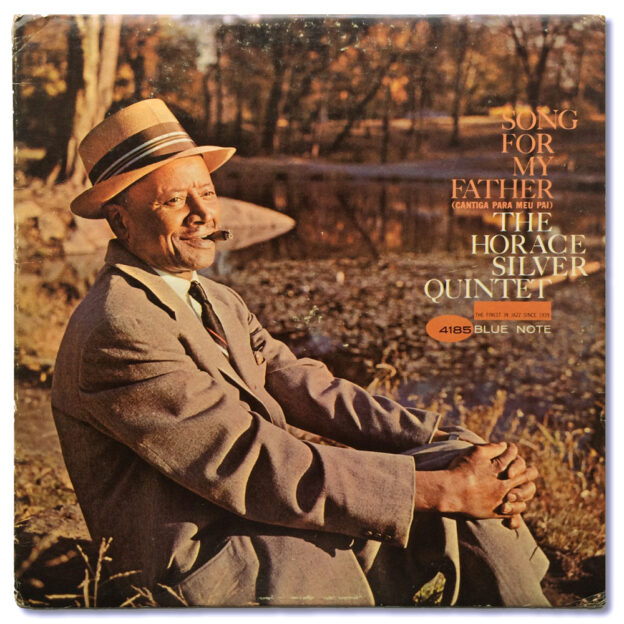
Vinyl Spotlight: Horace Silver, Song for My Father (Blue Note 4185) Original Mono Pressing
- Original 1964 mono pressing
- “NEW YORK USA” on both labels
- Plastylite “P” etched and “VAN GELDER” stamped in dead wax
- Deep groove on side 1
- “43 West 61st St., New York 23” address on jacket without “Printed in U.S.A.”
Personnel:
All but “Calcutta Cutie”, “Lonely Woman”:
- Carmell Jones, trumpet
- Joe Henderson, tenor saxophone
- Horace Silver, piano
- Teddy Smith, bass
- Roger Humphries, drums
“Calcutta Cutie”, “Lonely Woman” only:
- Blue Mitchell, trumpet (“Calcutta Cutie” only)
- Junior Cook, tenor saxophone (“Calcutta Cutie” only)
- Horace Silver, piano
- Gene Taylor, bass
- Roy Brooks, drums
“Calcutta Cutie” and “Lonely Woman” recorded October 31, 1963
All other tracks recorded October 26, 1964
All selections recorded at Van Gelder Studio, Englewood Cliffs, New Jersey
Originally released December 1964
| 1 | Song for My Father | |
| 2 | The Natives are Restless Tonight | |
| 3 | Calcutta Cutie | |
| 4 | Que Pasa | |
| 5 | The Kicker | |
| 6 | Lonely Woman |
Selection: “Lonely Woman” (Silver)
It makes sense that Song for My Father is part of many people’s introduction to the jazz genre. It is not only an essential part of the classic jazz canon, it is also a very accessible album. The minimalist structure of “Calcutta Cutie” and “Que Pasa” should cause just about anyone’s ears to perk up and listen. The album has everything: accessible tunes, a radio-friendly title track, two cooking sessions, and a gorgeous ballad. It certainly was one of the first albums I sought out. I first had the Rudy Van Gelder Edition CD, but when I started collecting jazz vinyl, this album was definitely near the top of my wish list.
The first time I came across an original pressing was at the Jazz Record Center in New York City. It was pretty exciting: I had just recently begun collecting and they had both original mono and stereo copies; I went for the mono. Though the record looked pretty darn clean when I bought it, to my dismay I later discovered that it suffered from audible groove wear. I bought another original mono copy on eBay with the same result before I got this copy via Buy It Now from a German seller. Although its visual condition is really only VG+, this copy is one of those rare instances where a vintage jazz record is scuffed up but free from groove wear and thus plays better than it looks.
My favorite song on this record is perhaps my favorite ballad of all time, “Lonely Woman”. It’s the last song on side 2, and because it’s the last song on the side I was faced with a particular dilemma. The phenomenon of inner groove distortion makes the innermost tracks on each side of a record more susceptible to groove wear, and this is exactly why my first two copies ended up for sale on eBay. Piano is an instrument especially prone to causing mistracing in the presence of groove wear, and on a ballad like this, that distortion is going to be easier to notice if it’s there. If you can find a Rudy Van Gelder-mastered original that’s free from groove wear like this one, the plus side to the engineer’s aggressive mastering techniques is that the music usually overpowers surface marks even in the most excessive of instances; listen above to hear the results.
Whereas my copy of this album has a deep groove on side 1 only, Fred Cohen’s Blue Note guide indicates that copies exist with deep grooves on both sides. But note that Cohen is very clear on page 77 of his guide when he explains the significance of deep grooves when evaluating the vintage of a Blue Note record:
“After a certain point, it can never truly be known whether similar pressings for the same record, whose only difference is the presence or absence of a deep-groove on one, both, or neither labels, is actually the original FIRST pressing. But since collectors have a natural bias for any detail that suggests an early or original issue, the presence of a deep-groove has been treated in this guide as an indication of an original, but ONLY an indication.”
Each of us is free to agree or disagree with him (I happen to think his scientific approach to the issue is exactly right) but I discourage the interpretation of the deep groove data in his guide as a definitive end-all-be-all as to what constitutes a first pressing for Blue Note albums released after the appearance of the first non-deep groove copies in 1961. There is no hard evidence suggesting that either deep groove or non-deep groove pressings of these albums always came first. For someone like myself, this means that in the event that all the other appropriate indicators are there, both deep groove and non-deep groove pressings should be considered first pressings. So if you have a copy of this album with the Van Gelder stamp and the “P” but no deep grooves, my advice is to consider it a first pressing.
The sound of this album is characteristic of Rudy Van Gelder’s work in the mid-1960s. As early as 1963 (see Lee Morgan’s The Sidewinder), one can hear Van Gelder pushing his compressors harder than ever, resulting in a saturated, thick sound. Horns meld together like glue, piano notes come thundering down like hammers, and drums have an in-your-face presence where each and every nuance is amplified to cut through the mix. Of the sides presented here, “Song for My Father” embodies this sound the most.
This album is a bonafide classic. It is yet another Blue Note staple filled with brilliant music, an album that beckons to be listened to from start to finish every time.

Vinyl Spotlight: Andrew Hill, Black Fire (Blue Note 84151) Liberty RVG Stereo Pressing
- Stereo Liberty reissue circa 1966-1970
- “A DIVISION OF LIBERTY RECORDS, INC.” on both labels
- “VAN GELDER” stamped in dead wax
Personnel:
- Joe Henderson, tenor saxophone
- Andrew Hill, piano
- Richard Davis, bass
- Roy Haynes, drums
Recorded November 8, 1963 at Van Gelder Studio, Englewood Cliffs, New Jersey
Originally released March 1964
| 1 | Pumpkin | |
| 2 | Subterfuge | |
| 3 | Black Fire | |
| 4 | Cantarnos | |
| 5 | Tired Trade | |
| 6 | McNeil Island | |
| 7 | Land of Nod |
Selections:
“Pumpkin” (Hill)
“Black Fire” (Hill)
First and foremost, I think this is one of the greatest album covers of all time. I love the juxtaposition of the bold strips of various red hues with the cartoony black-and-white illustration of fire beneath. Reid Miles’ cover design speaks volumes and yet again complements the music incredibly well.
From the time Andrew Hill arrived at Blue Note in 1963, it didn’t take long for the pianist-composer to venture “out” and away from bop. Hill first recorded for the label in September of that year with Joe Henderson (Our Thing, Blue Note 4152), then with Hank Mobley the following month (No Room for Squares, Blue Note 4149). Black Fire, Hill’s first album as a leader for Blue Note, was recorded in November 1963 and gives us an early glimpse at Hill loosely conforming to the higher degree of harmonic and melodic structure commonly found in bop. Blue Note would continue to document Hill’s musical explorations in the coming months, laying to tape Smokestack, Judgment!, then finally Hill’s avant-garde classic Point of Departure in March 1964 — the same month that Eric Dolphy recorded his landmark album Out to Lunch! for the label.
This album is about as far out as I’m willing go into the free jazz sea. I’m not a fan of free jazz and don’t know much about it, but from the little I do know I’m willing to say that Black Fire tows the line between post bop and the avant-garde. The sounds here tend to invoke a subtle feeling of panic, but much like another favorite mid-sixties quartet album of mine, Black Fire maintains a surprising degree of calm and quietude through all of the chaos. We also get to hear Roy Haynes on an uncommon Blue Note date and he doesn’t disappoint, demonstrating his patented pinpoint precision and tight snare drum work throughout.

